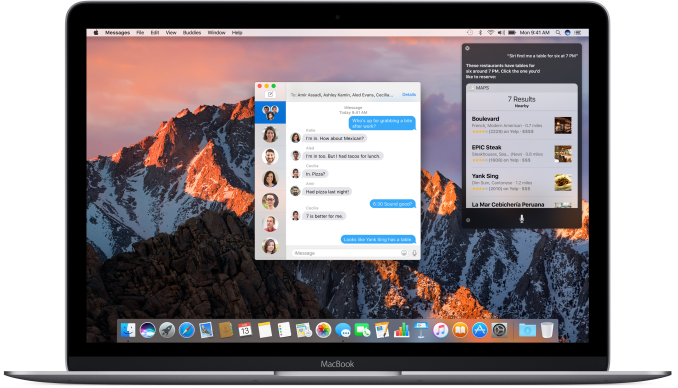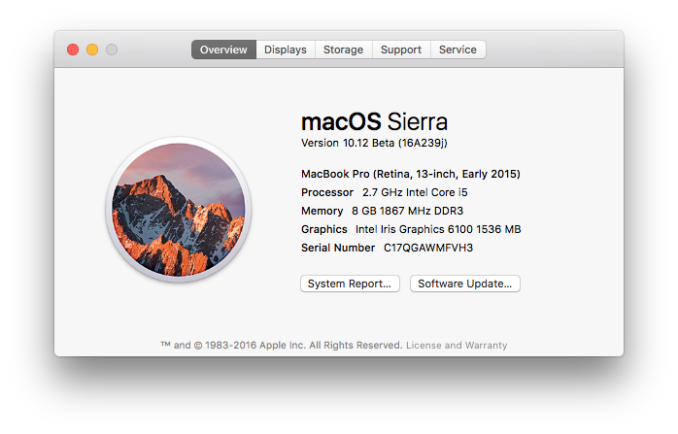A First Look At Apple's macOS Sierra
by Brandon Chester on July 13, 2016 8:00 AM EST- Posted in
- Mac
- Apple
- Operating Systems
- macOS

As with past years, Apple's WWDC 2016 keynote showcased the upcoming updates to Apple's operating systems and developer tools. It's hard to believe that iOS is now on its tenth major version, which put Apple in an interesting position since their desktop operating system has been called OS X for many years now. Given that Apple's other operating systems are named iOS, watchOS, and tvOS, the name OS X has become a bit of an outlier. This year's release comes with a new name in the typical manner that OS X releases each had a specific name, but also a new name for the operating system itself. The 2016 version of Apple's operating system for Macs is named macOS Sierra.
While macOS adopts a new name, it retains the existing versioning system, with macOS Sierra being version 10.12. This makes sense when you consider the progression from Mac OS 9 to Mac OS X, which then treated each release as a point update on top of ten and only dropped the Mac in the name in 2012. This kind of versioning is somewhat awkward, and will be more so when it gets to the point where the OS is version 10.20. It will be interesting to see if the next truly large update to macOS brings it to major version eleven, and it could be that Apple plans to keep it in sync with iOS with a new major version number each year, but only time will tell.
Like all updates to macOS, Sierra comes with a number of new features. With the bulk of Apple's device sales being mobile devices, there have been a number of features in recent versions of macOS that work to leverage how devices running macOS, iOS, and watchOS can work together. Having cloud sync across devices is one thing, but building and properly executing Apple's continuity features really requires control over the hardware and software stacks across all devices. Unfortunately it's difficult to test these features during Apple's beta period, but that just gives Apple's users things to look forward to later in the year.
More important than new features is whether or not a Mac can even be upgraded to macOS Sierra from OS X El Capitan. Apple has announced the compatibility list for Sierra, and there are some older Macs that have dropped off the list. I've put together a chart comparing the compatibility of Macs with El Captain and compatibility with Sierra.
| OS X El Capitan | macOS Sierra | |
| MacBook Pro | Mid 2007 and newer | 2010 and newer |
| MacBook Air | Late 2008 and newer | 2010 and newer |
| Old MacBook | Late 2008 aluminum and newer | Late 2009 and newer |
| New MacBook | 2015 and newer | |
| iMac | Mid 2007 and newer | Late 2009 and newer |
| Mac Mini | Early 2009 and newer | 2010 and newer |
| Mac Pro | Early 2008 and newer | 2010 and newer |
As you can see, it looks like Apple has put the cutoff point right around the start of this decade. The old MacBook and iMac that released in late 2009 make the cut, but everything else has to be a model from 2010. The uniformity of the cutoff makes it fairly likely that this was a somewhat arbitary decision, although it's difficult to say exactly how many older Macs could have been put on the list because Apple offers many SKUs and CTO options that could make one version of an older Mac fast enough and another from the same line too slow. In any case, the easy rule with Sierra is that if your Mac is from before 2010 it's probably not supported, and if you're in that group you're probably overdue for an upgrade anyway.
With Apple having just released their public beta of macOS Sierra, it's worth going over the major features that are currently available for users to try before the OS is officially launched later this year. Features like Auto Unlock and Apple Pay on the web can't really be shown right now, but it is possible to show other features that work between iOS and macOS devices like the additions to Messages and Photos. While I think the smaller and more subtle features in software updates can be some of the most useful, It's probably best to start off with the biggest feature in Sierra, which is Siri coming to the Mac.











81 Comments
View All Comments
Wheaties88 - Wednesday, July 13, 2016 - link
Any chance of being able to just clone a copy of macOS Sierra onto the drive of a non-supported Mac and getting it to boot?DPUser - Wednesday, July 13, 2016 - link
http://forums.macrumors.com/threads/mac-pro-3-1-in...Wheaties88 - Wednesday, July 13, 2016 - link
Thanks. I might have to try that on an older MacBook I have.casperes1996 - Thursday, July 14, 2016 - link
So, just to clarify something.The PiP window doesn't have to snap to the corners of the screen. It's just the default behaviour. If you drag it around while holding command, the floating window can be placed anywhere.
Furthermore, there's also a new, unmentioned window management feature; Snapping. It's not like the Aeuro snap thing on Windows, but moving a window to the edge of another, or resizing it or something, will result in the window, sort of magnetically sticking slightly when it reaches the edge of the other window, or the boundary of the screen. It can still be stretched beyond that point, but it's faster and easier to line things up exactly edge to edge.
Alexey291 - Thursday, July 14, 2016 - link
Oh look more clickbait. Quelle surpriseApePriori - Thursday, July 14, 2016 - link
Thanks for the article, I've been coming here everyday for many years to see what's up. I find no desire to whine about the 95% non-apple content. In fact, I read it happily, because reading is fun and you learn something new every day. Sometimes it takes a day or two before a new article is up. I don't care. Anand took a job at Apple. So what? Good for him, he's a smart guy and why shouldn't he move on? If anything the Apple content has been less since Anand left, since clearly he was excited by the technology and the company. His Apple AX CPU dives were excellent reading, whatever your platform of choice. No matter, Ryan and company have done an excellent job since Anand left, the overall character and content of the site has remained the same.Sadly, one of the things that has never changed are all the pointless complaints that have nothing to do with the content of Apple related articles in particular. It's just a constant barrage of platform identity complex and content entitlement syndrome on full display. It's incredibly tiresome and brings down the quality of an otherwise excellent site. Whining about platforms, disparagement of the editors, fomenting about the ratio of x content to y content, blah blah blah... boring.
Right now there are three articles about apple stuff on the entire home-page scroll of about 45 articles, strangely the apple articles all share an identical flood of complaints about publishing the article while the non-apple articles are followed by relatively sober discussions about the content of the article. Ironically all of this complaining and platform trolling in Apple articles only proves that Anandtech has not changed much at all over time, contrary to what these commenters want to believe. This is still largely a Win/PC and Android focused site with a side of Apple product, pretending otherwise is childish.
Anyway, sincere thanks to all the editors and writers for all of the articles covering all of the platforms over the years here on Anandtech. Don't let the cesspool of the comments get to you, you're doing a great job.
Dennis Travis - Friday, July 15, 2016 - link
Well said.Oxford Guy - Friday, July 15, 2016 - link
Anti-Apple sentiment is a very old thing in the tech world. You haven't gotten use to it by now?ApePriori - Friday, July 15, 2016 - link
Yes, being a mac user since 1988 I am all to familiar with it. Believe me, I ignore it by default and do not generally waste time worrying about it. On the other hand it's 2016, the horse has been flogged into a bloody mist, and the overwhelming stupidity of it all can inspire a rare comment from me regarding same, if you don't mind.ex2bot - Friday, July 15, 2016 - link
Thanks for the article! I appreciate the Apple content, and, as I'm capable of using multiple computing platforms, I appreciate the non-Apple content, too.The comment in the article about iOS having no accessible file system is incorrect. iOS has had accessible files since 2007 when the first iOS device came out.
I know the author actually meant an "open" file system in the sense that files saved by one app are accessible to others, iOS has that, too, since iOS 8. It's called iCloud Drive. The files do exist on Apple's remote servers, but they (can) also exist on the device and they are accessible from other apps. For example, I can access iCloud Drive files saved by various apps in Mail app to attach to email messages.